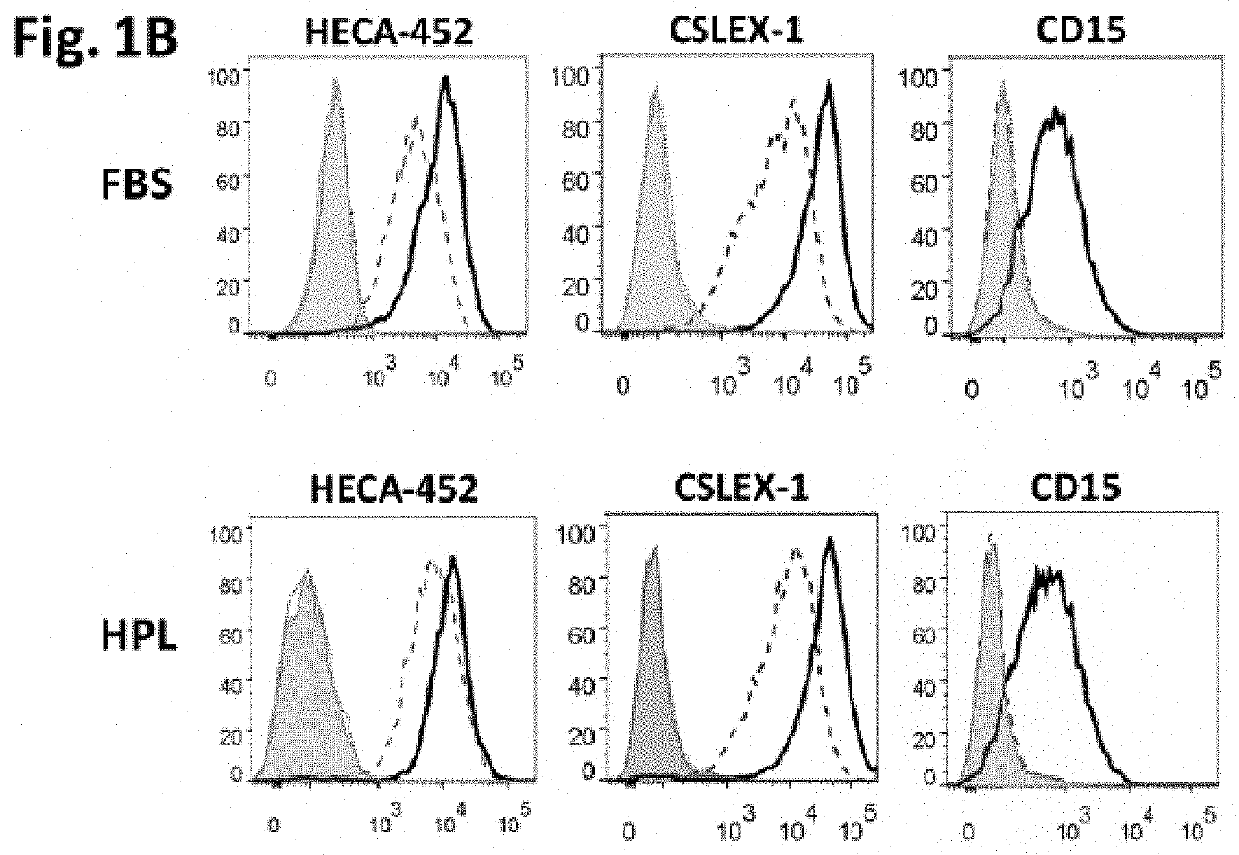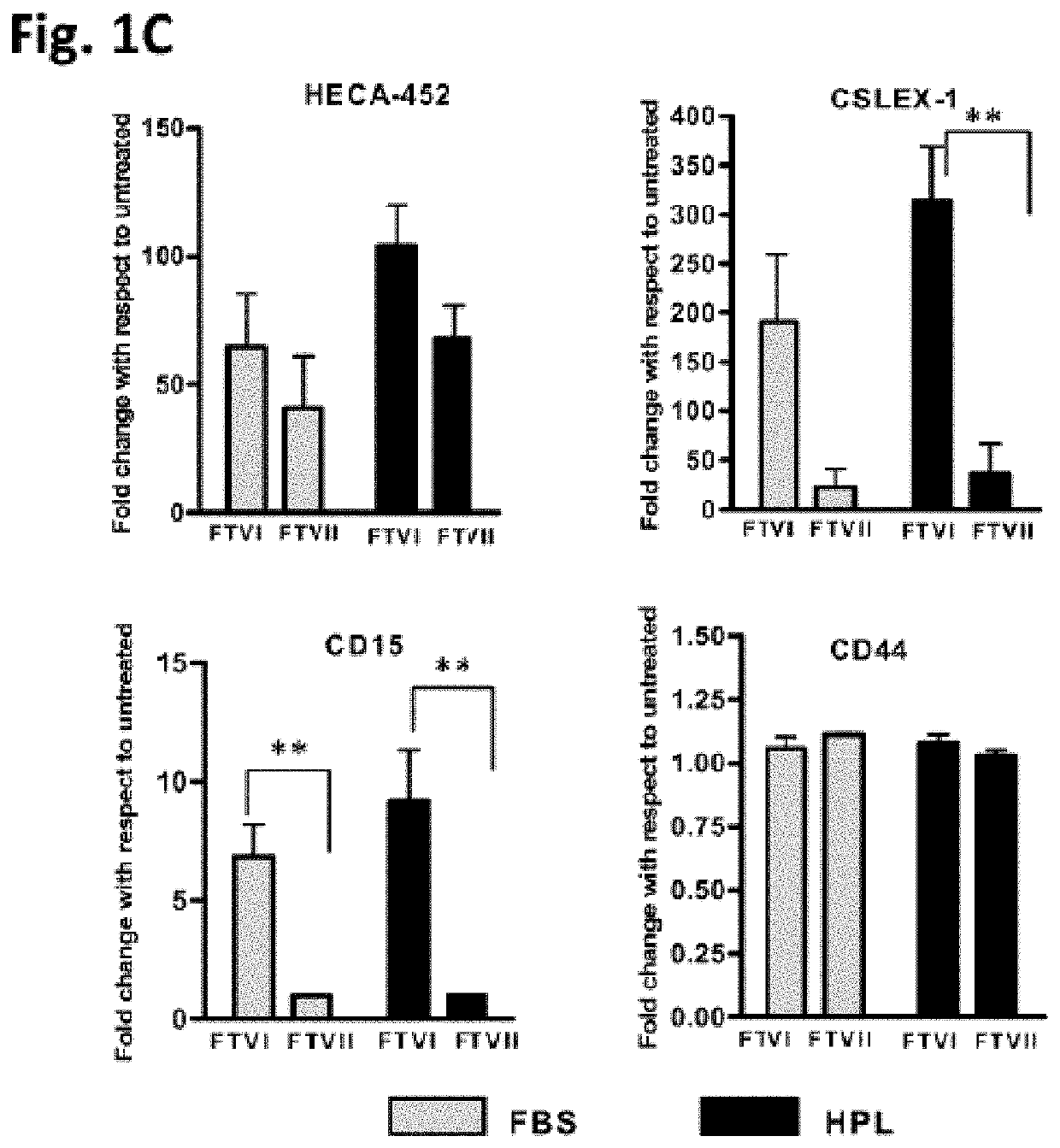Compositions and methods for production of exofucosylated cells for clinical applications
a technology of exofucosylated cells and compositions, applied in cell culture active agents, instruments, skeletal/connective tissue cells, etc., to achieve the effect of safe production of hpl-expanded cells, full cell viability and phenotyp
- Summary
- Abstract
- Description
- Claims
- Application Information
AI Technical Summary
Benefits of technology
Problems solved by technology
Method used
Image
Examples
example 1
[0143]Isolation, Culture and Expansion of Human hMSCs
[0144]This research effort was approved by the Institutional Review Boards of the University Hospital Virgen de la Arrixaca (Murcia, Spain) and of Partners Healthcare System (Massachusetts General Hospital / Brigham & Women's Hospital, Boston, Mass.). As needed, written informed consent was obtained from donors as per Helsinki Declaration guidelines. To obtain HPL, discarded platelet transfusion bags were frozen at −80° C. then thawed at 37° C. Lysates were centrifuged at 900 g for 30 min, and the supernatants were then collected, aliquoted and stored at −20° C.
[0145]For laboratory-scale experiments comparing the two different culture and plate-lifting conditions (i.e., the use of FBS / porcine trypsin (Gibco, Grand Island, N.Y.) and the use of HPL / TrypLE Select (Gibco) reagents), hMSCs were obtained from remnant cells within collection bags and filters of BM harvests of normal donors (for hematopoietic stem cell (HSC) transplant) at ...
example 2
[0158]FTVI- and FTVII-Mediated α(1,3)-Fucosylation of hMSCs Cultured with Either FBS or HPL Converts Cell Surface CD44 into HCELL
[0159]Clinical application of glycoengineered cells favors the use of reagents that are free of animal-derived components. To this end, we aimed to assess whether CD44 could be efficiently exofucosylated into HCELL on hMSCs expanded in vitro using HPL as supplement for culture medium instead of FBS. First, we studied the efficiency of exofucosylation using the human hematopoietic cell line RPMI 8402; similar to hMSCs, these cells are CD44+ and natively lack expression of sLeX (as measured using the anti-sLeX mAb HECA-452), and they also express a CD44 glycovariant that possesses sialylated type 2 lactosamine residues that can serve as acceptors of α(1,3)-fucosyltransferases (24-25). As such, after exofucosylation with either FTVI or FTVII, RPMI 8402 cells are HECA-452-reactive (i.e., express the sLeX determinant) (FIG. 1A, right).
[0160]To assess whether hM...
example 3
n
[0171]In recent years, encouraging results have been published on the clinical safety and potential efficacy of hMSCs as a cell therapy medicinal product in diverse pathological entities. Preclinical studies and clinical trials, mostly phase-I and phase-II, have shown an absence of major adverse effects (40-44). Regarding efficacy, promising results of intravenous administration of autologous and allogeneic hMSCs have been obtained in pathologies such as osteogenesis imperfecta, refractory graft-versus-host disease, inflammatory bowel disease, and rheumatoid arthritis (17-21,45,46). However, the inability of systematically-administered cells to enter affected sites of tissue injury / inflammation is a factor that could be limiting the achievement of better clinical outcomes. Exofucosylation of hMSCs to enforce the CD44 glycoform HCELL, according to the results published by Sackstein et al. (25,47), increases the tropism of hMSCs for E-selectin-expressing tissues such as BM microvascu...
PUM
| Property | Measurement | Unit |
|---|---|---|
| v/v | aaaaa | aaaaa |
| v/v | aaaaa | aaaaa |
| mw | aaaaa | aaaaa |
Abstract
Description
Claims
Application Information
 Login to View More
Login to View More - R&D
- Intellectual Property
- Life Sciences
- Materials
- Tech Scout
- Unparalleled Data Quality
- Higher Quality Content
- 60% Fewer Hallucinations
Browse by: Latest US Patents, China's latest patents, Technical Efficacy Thesaurus, Application Domain, Technology Topic, Popular Technical Reports.
© 2025 PatSnap. All rights reserved.Legal|Privacy policy|Modern Slavery Act Transparency Statement|Sitemap|About US| Contact US: help@patsnap.com



